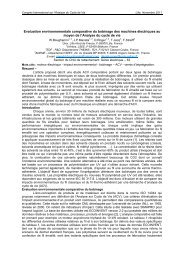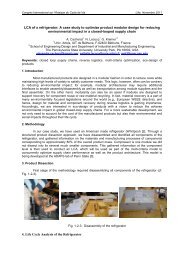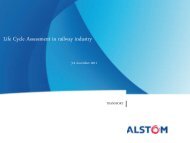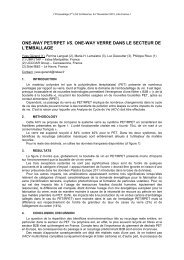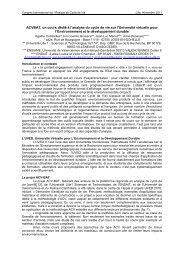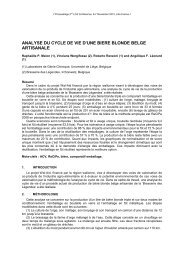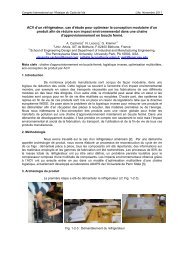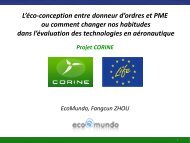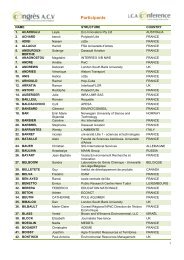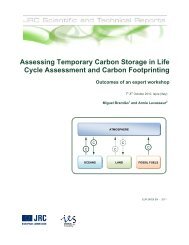Untitled - avniR
Untitled - avniR
Untitled - avniR
You also want an ePaper? Increase the reach of your titles
YUMPU automatically turns print PDFs into web optimized ePapers that Google loves.
Congrès International sur l’Analyse du Cycle de Vie Lille, Novembre 2011<br />
Integrating LCA into Product Design<br />
Finding creative ways of engaging designers with life cycle thinking and eco-design<br />
Leyla Acaroglu*, Tim Grant** and Monique Ladds***<br />
*RMIT University and Eco Innovators, Suite 12, Level 11, 125 Swanston Street Melbourne, 3000, Australia<br />
**Life Cycle Strategies, Suite 12, Level 11, 125 Swanston Street Melbourne, 3000, Australia<br />
***Monique Ladds, RMIT University, Building 251 Level 2 Room 53, Plenty Rd Bundoora East Campus VIC 3083<br />
Leyla@ecoinnovators.com.au, tim@lifecycles.com.au, Monique.ladds@rmit.edu.au<br />
Key words: eco-design, life cycle thinking, new media education, LCA education, teaching methods<br />
1. Introduction<br />
LCA is a powerful and effective tool for assessing the whole of life environmental impacts of a<br />
product, system or service, however there is still progress to be made in the application and uptake of LCA<br />
within the design and product development communities (Sherwin, 2004; Telenko, Seepersad & Webber<br />
2008). Whilst LCA has advanced in the technical area substantially over the past 20 years, communicating<br />
LCA results, principals and learning’s to people involved in product design and development has been<br />
substantially lacking (Acaroglu, Ladds & Grant 2011; Boks 2006; Fargnoli & Kimura 2006). Barriers to the<br />
uptake of LCA include the time consuming nature and level of technical complexity required to conduct an<br />
assessment as discussed by Eisenhard (2000) and Telenko (2008).<br />
A key opportunity for increasing awareness and capacity is within higher education in design. To<br />
address this the ‘Secret Life of Things’ (SLOT) project was developed by Eco Innovators to create an<br />
innovative multimedia based approach to educating designers and the public about the concepts and<br />
practice of life cycle thinking and eco-design in product development.<br />
This paper will present the SLOT LCA animation project, learning objectives and the outcomes of<br />
the research evaluating the effectiveness of new media as a form of engagement with design students in<br />
increasing their understanding of key LCA and eco-design concepts from an Australian context.<br />
2. The Secret Life of Things Animation Project<br />
The Secret Life of Things project is a series of freely available online e-learning resources used for<br />
inspiring and engaging students with life cycle thinking, eco-design and sustainability in production and<br />
consumption. The project is focused around a series of short animation videos (one has been developed<br />
to date) that address different issues in product design, development and consumption. The animations<br />
are targeted at Generation Y viewers and use humour and pro-active approaches to engage the viewer<br />
with environmental issues and impacts of everyday objects.<br />
In combination with the animation there are fifteen e-resources including games, case studies, fact<br />
sheets and class exercises, covering topics such as eco-design strategies, life cycle thinking, and product<br />
stewardship. The animation and e-resources can be accessed for free from the website<br />
www.thesecretlifeofthings.com which has been developed as a resources hub for teachers and students.<br />
The main objective of the project is to assist with infusing sustainable design into the curriculum of higher<br />
education settings so that sustainability becomes an inherent part, not an ‘add on’ to the design process<br />
for future designers.<br />
The first SLOT animation, ‘Life Pscycle-ology’, is about exploring the life cycle based<br />
environmental impacts associated with everyday consumer products, and in this case a mobile phone. The<br />
animation was designed to leave the viewer with an interest and knowledge of the life cycle stages that a<br />
product goes through and result in an increased awareness of eco-design solutions – in this case design<br />
for disassembly and design for longevity. This is presented in a humours story, whereby the environmental<br />
information is wrapped up in a narrative. In this short animation we meet Eric who is an unhappy mobile<br />
phone, he seeks therapy after his owner abandons him in favour of a new model. The five minute<br />
animation goes through the life cycle stages of Eric’s past (in the form of past life regression therapy) and<br />
provides some of the solutions that could be engaged with from a design and consumer perspective to<br />
reduce and alleviate theses impacts.<br />
2.2 Project Evaluation<br />
Industrial design programs in six universities across Australia participated in a trial of the SLOT<br />
project. 257 students participated in the research, completing an initial survey at the start of the semester<br />
questioning their opinions and activities towards environmental issues, design responsibility and their level<br />
of understanding of key eco-design terms. A follow up survey was conducted at the end of semester with<br />
100 of the students after they had been exposed to the animation and resources throughout the semester.<br />
The quantitative data was statically analysed in SPOS to indentify if there was any relevant changes or<br />
increases in knowledge in the sample group.<br />
The initial survey results demonstrated that most students believe that it is ‘mostly’ or ‘very’ true<br />
that designers and consumers can influence the environmental impacts of their products from their design<br />
and purchasing decisions. Further to this the majority of surveyed students beloved that companies have a<br />
responsibility to create environmentally friendly products and that the design industry has an important role<br />
- 107 -



